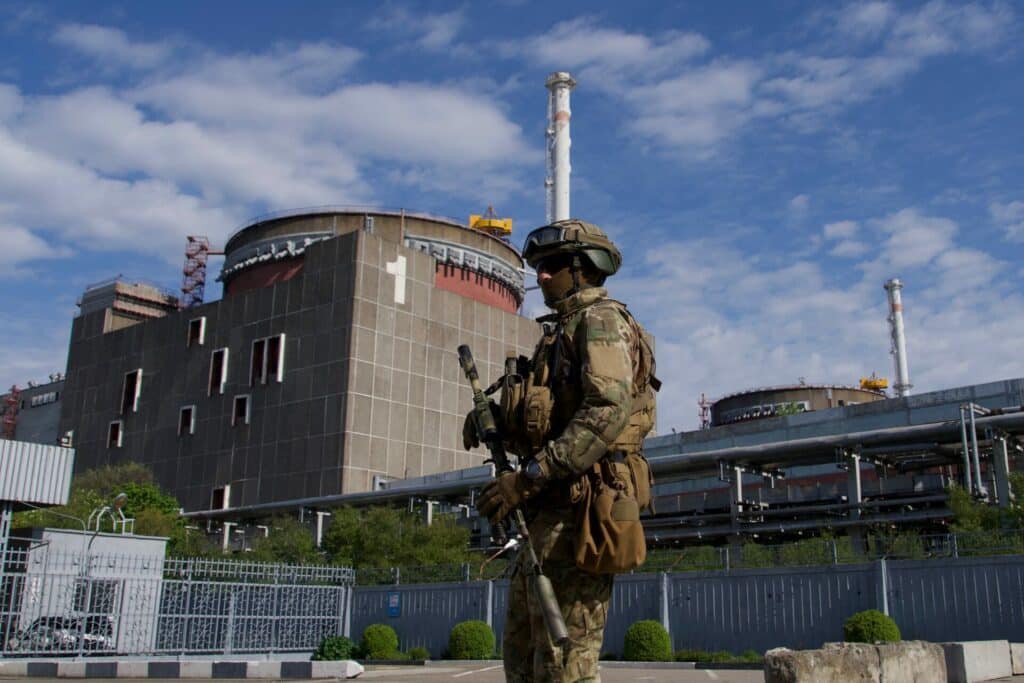Matthew Bunn

Ever since its seizure by Russian forces in March 2022, the Zaporizhzhia nuclear power plant—Europe’s largest, with six reactors—has posed a serious danger of a radioactive disaster. Now, Ukrainian officials have charged that Russia has rigged the plant with explosives, while Russia claims that Ukraine plans an attack on the facility. On July 4, the site lost off-site power yet again, forcing its cooling systems to rely on backup power supply. How serious is the risk of a major radioactive disaster?
That depends on whether we’re talking about an intentional or inadvertent radioactive release. If the Russian forces that control the site want to cause a major radiation release— and are willing to use explosives to do it—they could contaminate a huge area. Although the reactors have been largely shut down and cooling for months, they still contain a huge amount of intensely radioactive material that explosives could disperse.
A couple of mines on the roof of a reactor would not be enough. Causing a big release would require some serious demolition with explosives. But that’s what was needed to destroy Ukraine’s Kakhovka dam—which it appears was done with explosives from within, while Russian forces controlled the site—so a similar operation at Zaporizhzhia can’t be ruled out.
No one can accurately evaluate how big an area might be affected; the extent of contamination would depend on how the disaster was caused, how hard the wind was blowing, whether rain brought the radioactive material back to the ground, and more. But one could easily imagine that Russia might hope that such a release would interfere with Ukraine’s counteroffensive, forcing some units to focus on evacuating people and cleaning up radioactive fallout rather than battling Russian forces.
By contrast, looking only at inadvertent damage, there are reasons to be optimistic. The Zaporizhzhia reactors are built with thick concrete containment structures, have been cooling for months, and have extra safety features installed after the Fukushima accident in Japan. It is very unlikely that a few stray shells from fighting in the area would cause any serious radioactive release.
Such fighting might damage the cooling systems that keep the hot radioactive fuel in the reactor cores and spent fuel pools covered with water, preventing the fuel from melting. With the reactors as cool as they now are, however, it could take quite a while—a matter of days or weeks—before the water boiled off and the fuel began to melt (unless someone sabotaged the plant, draining the water).
If people who wanted to prevent an accident gained access to the site, they might well be able to replenish the cooling water in the time available—if fighting in the area did not stop them. Even if the fuel did melt, the steel pressure vessels of the reactors and the concrete containment buildings around the reactors and the spent fuel pools might well prevent a large release of radioactivity.
In Japan, explosions of hydrogen released from reactions between melting fuel and high-pressure steam destroyed the containments. But after Fukushima, Zaporizhzhia’s Ukrainian operators installed both hydrogen recombiners, to prevent explosive levels of hydrogen from building up, and filtered vents that allow steam to escape if pressure inside the containment threatened to break it.
In short, the biggest dangers to the Zaporizhzhia reactors involve intentional military action aimed at causing a radiation release. Unfortunately, with Russian military forces in control of the site, there’s not a lot the rest of the world can easily do to stop such an intentional disaster from happening. The International Atomic Energy Agency (IAEA) has two inspectors on-site, and they can continue to ask that they be given the access needed to look for explosives and to provide additional help to the highly stressed reactor staff at the site. The UN and various individual countries can demand that all parties abide by the principles of nuclear safety in war that IAEA Director General Rafael Grossi laid out in May 2023.
But at the same time, it’s important to prepare for the worst—as Ukraine did in carrying out recent exercises to test its response to a nuclear disaster. The United States, other countries, and the IAEA are all helping Ukraine prepare for emergency response and can step up that help. In particular, the World Health Organization and others should work with Ukraine to establish a network of trained mental health professionals prepared to help people cope with their fear and depression should an accident occur—often the biggest effects of such a disaster.
Over the longer term, there’s a need to rethink nuclear safety and security in the context of the possibility that nuclear facilities can be exposed to war, mass civil unrest, or governmental collapse. And there’s a need for new agreements to reduce the chance that major civilian nuclear facilities under international inspection will again be targets of military assault.
No comments:
Post a Comment